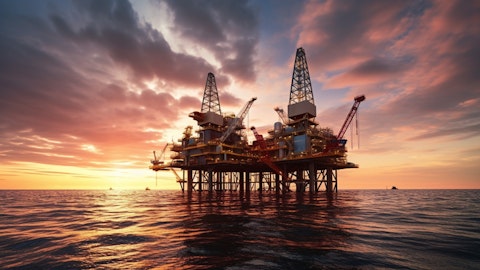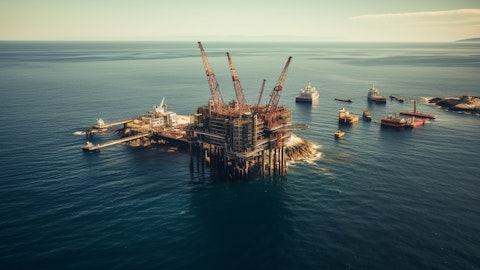Diamondback Energy, Inc. (NASDAQ:FANG) Q4 2023 Earnings Call Transcript February 21, 2024
Diamondback Energy, Inc. isn’t one of the 30 most popular stocks among hedge funds at the end of the third quarter (see the details here).
Operator: Good day and thank you for standing by. Welcome to the Diamondback Energy Fourth Quarter 2023 Earnings Conference Call. At this time, all participants are in a listen-only mode. After the speakers’ presentation, there will be a question-and-answer session. [Operator Instructions]. Please be advised that today’s conference is being recorded. I would now like to hand the conference over to your speaker today, Adam Lawlis, VP of Investor Relations. Please go ahead.
Adam Lawlis: Thank you, Daniel. Good morning, and welcome to Diamondback Energy’s fourth quarter 2023 conference call. During our call today, we will reference an updated investor presentation and Letter to Stockholders, which can be found on Diamondback’s website. Representing Diamondback today are Travis Stice, Chairman and CEO; Kaes Van’t Hof, President and CFO; and Danny Wesson, COO. During this conference call, the participants may make certain forward-looking statements relating to the company’s financial condition, results of operations, plans, objectives, future performance and businesses. We caution you that actual results could differ materially from those that are indicated in these forward-looking statements due to a variety of factors.

Information concerning these factors can be found in the company’s filings with the SEC. In addition, we will make reference to certain non-GAAP measures. The reconciliations with the appropriate GAAP measures can be found in our earnings release issued yesterday afternoon. I’ll now turn the call over to Travis Stice.
Travis Stice: Thank you, Adam, and I appreciate everyone joining this morning. I hope you continue to find the stockholders letter that we issued last night, an efficient way to communicate. So obviously a lot of the material is in that stockholders letter. So with that operator, would you please open the line for questions?
See also 30 High-Paying Side Hustles to Start For Extra Income in 2024 and 12 Happiest Jobs In The World in 2024.
Q&A Session
Follow Diamondback Energy Inc. (NASDAQ:FANG)
Follow Diamondback Energy Inc. (NASDAQ:FANG)
Operator: [Operator Instructions]. Our first question comes from Neal Dingmann with Truist Securities. Your line is now open.
Neal Dingmann: Well, good morning, Travis and team. Thanks for the time. Guys, my first question is on Endeavor specifically, just want to go back to this. You all highlighted about 344,000 acres with about 2,300 locations, that compares to 494,000, 3,800 for you all. And I’m just wondering, does this slightly smaller current core footprint provide a material amount of immediate incremental locations, Travis. And I’m just wondering or potential upside and I’m wondering how you would thinking about I know it’s still a while until this thing likely closes but how you will attack these assets.
Travis Stice: Yes, Neal. I mean listen, we wanted to be conservative and how we laid out the inventory counts for both us and them sub 40, I mean I think there’s been a lot of aggressive inventory counts put in deals lately. And I think for us to be able to say that combined we have about 12 years of sub 40 breakeven inventory is truly a best-in-class number in North American shale and that’s kind of why we put it there. I mean I think generally as with Diamondback’s position, there’s a lot of inventory that breaks even well above those numbers. I think there’s a lot of testing going on throughout the basin. There’s probably some zones like the Upper Spraberry that we’d probably call a sub 40 breakeven zone today. But I don’t think they’re ready to fully put it in the location count.
So I think it’s just conservatism. And I think on a relative basis not all locations are created equal and within that combined 6,000 location count, there’s some that breakeven below 30, right. I mean it’s all about what we’re developing today and saving the upside for later. And we know that that upside is going to accrue to us with the size of the acreage position pro forma.
Kaes Van’t Hof: Neal, just to add to that point if you think about a company’s future two things are really important for the oil and gas sector. One is kind of this durable inventory in case just walked you through some numbers there. But it’s also the conversion efficiency of that inventory and I think now with the announcement of this Endeavor merger, we’re in control of both the numerator and denominator of that ratio. So our durable inventory greatly extends and then our conversion efficiency that we’ve been known for a long time actually gets to come to bear on a larger asset base. And I think to give you a little bit more color and comfort; we didn’t put our thumb on the scale as we looked across the barbed wire fence.
And what I mean by that is we simply applied what Diamondback is doing today on drilling and completion and operating wells and then physically adjacent. This case was just explaining, made the assumption that that can be applied across the barbed wire fence. So I wanted to give you a little bit more color there, Neal. Thanks for your question.
Neal Dingmann: No, I appreciate both and I definitely appreciate the conservatives. And I think your right case has been something inflated. And my second question is on your current Slide 11 of today on the multi-zone development strategy specifically. Really like that you all for 2024 had — sorry, for 2023 had the average project size of around 24 wells. And I’m just wondering will that be approximately the same this year? And I’m just wondering with that how do you all continue to mitigate the frac hits that seem to plague other operators so much when they do these larger projects?
Travis Stice: Yes. Well, I mean I think generally Neal; the project size is up, I mean 25 is not an exact number. It’s going to be different, different counties where you have different spacing within different zones. We’re not — we don’t use a cookie cutter strategy to develop the asset. We use a unique development strategy for each area. I think we’ve had a lot of experience with practice over the years. I think we’ve learned and our planning group has gotten significantly better at looking around the corner and seeing what issues might arise. And certainly, there’s a benefit of size and scale, right? If we have one of these 24 projects coming on every quarter, well, there’s a lot of risk in that one particular project. But here we have four, five, six of these coming on every quarter.
And that allows us operational flexibility to move around and plan our business. And that’s just one of the other benefits of size and scale that will only be magnified with the potential with the Endeavor merger.
Kaes Van’t Hof: And Neal, when you look at our 2024 budget, you kind of see that the capital efficiency shining through because we’re essentially maintaining the volumes profile that we had in the fourth quarter, but we’re doing so with 10% less CapEx. And as case we’re just talking to our development strategy yields the same well performance. So I think as we look across the industry universe, capital efficiency for this year is going to be very, very important. And I like the way that our budget execution is shaping up in terms of that capital efficiency.




